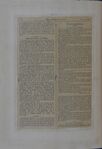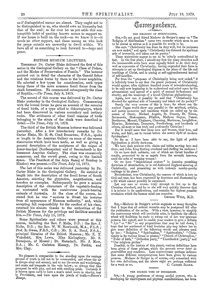
< Spiritualism and Religion (continued from page 8-303) >
us if distinguished names are absent. They ought not to be distinguished to us, who should own no hierarchy but that of the soul; so for ever let us put aside this contemptible habit of quoting known names to support us. If our house is built on the rook—as we know it is—it needs no other support, and those among us who look for props outside are unworthy to dwell within. Wo have all of us something to look forward to—hope and peace.
British Museum Lectures
Yesterday Dr. Carter Blake delivered the first of this series in the Geological Gallery on. the “Class of Fishes, and the Modes of Preservation of Fossils.” The lecturer pointed out in detail the character of the Ganoid fishes and the relations borne by them to the lower amphibia. He selected a few types for consideration, such types being those of the more common fossil forms from the chalk formations. He commenced subsequently the class of Reptilia.—The Times, July 8, 1879.
The second of this course was delivered by Dr. Carter Blake yesterday in the Geological Gallery. Commencing with the lowest forms he gave an account of the remains of fossil birds, of a type allied to Odontopteryx, which had been discovered in various secondary and tertiary rocks. The evidences of other fossil remains of birds belonging to the strata of the chalk were described in detail.—The Times, July 10, 1879.
The third of the British Museum lectures was delivered yesterday. After a few introductory remarks by Dr. Carter Blake, Mr. H. St. Chad Boscawen, F.S.A., spoke at length in the Assyrian Gallery on some of the recent discoveries which have been made, as well as giving a general description of the sculptures of the reigns of Assur-dan-ipal (Sardanapalus) and of Sennacherib in the basement Assyrian Gallery. The class was excessively numerous, and the crowd, great, owing to the limited space. The President of the Arya Samaj of Bombay (a Hindoo) was present.—The Times, July 12, 1879.
The last of this series was delivered yesterday by Dr. Carter Blake in the Geological Gallery. He entered at length into the description of the fossil forms of South America, selecting the glyptodon, megatherium, and toxodon as examples. Subsequently he gave a minute description of the characters of the vegetable-feeding as contrasted with the carnivorous pouch-bearing animals of Australia. At the close of the course, he stated that he was “anxious to divest his lectures from all appearance of Museum authority,” and, while accepting full responsibility for the conduct of his class, returned his sincere thanks to the authorities of the British Museum for the privilege and facilities accorded him.—The Times, July 15, 1879.
Some Spiritualists and others were present at this course, ineluding the Rev. P. Melia, D.D.; the Rev. J. Nolte, D.D.; the Rev. W. W. Newbould, M.A., F.L.S.; Prof. R. Owen, F.R.S., C.B.; Mr. E. A. Bond, F.S.A., principal librarian of the British Museum; Mr. E. T. Wakefield, Mrs. Lowe, Miss Kislingbury, Mr. S. Burasjoon, of Mossul; Dr. Herschell, Mr. J, Mew, B.A.; Mr. C. Carleton Massey, Dr. Perfitt, and Mrs. Clay.
No pleasure is comparable to the standing upon the vantage ground of truth (a hill not to be commanded, and where the air is always clear and serene), and to see the errors and wanderings, and mists and tempests in the vale, below; so always that this prospect be with pity, and not with swelling pride. Certainly it is heaven upon earth to have a man’s mind move in charity, rest in Providence, and turn upon the jewels of truth.—Bacon’s Es says.
The Religion of Spiritualist
Sir,—In my good friend Madame de Steiger’s essay on “The Religion of Spiritualism” occur two remarks which seem to me to be almost as untrue as it is possible for words to be.
She says “Christianity has done its duty well, but its purposes are now ended,” and again “Christianity has dimmed the spiritual side of humanity, and taken out its poetry.”
These statements appear to me to be utterly contradicted by fact. In the first place, I should say that the many churches and the innumerable sects have most signally failed to do their duty well as exponents of Christianity, having expended their force in attempts to set up theological dogmas in the place of the life and teachings of Christ, and in aiming at self-aggrandisement instead of self-sacrifice.
Far from the “purposes of Christianity being now ended,” it is infinitely truer to say that the grand purposes of Christianity would appear, after eighteen hundred years of misunderstanding, to be only now beginning to be understood and acted upon by the advancement and spread of a spirit of mutual forbearance and charity, and the teachings of a broad Christian philanthropy.
Again, how can it possibly be said that “Christianity has dimmed the spiritual side of humanity and taken out its poetry?”
Surely the very reverse of this is true; for where can the ancient Pagan world show any parallel to the spiritual, artistic, and poetic memories and emotions which are called up by the names of Dante, Michael Angelo, St. Francis, St. Teresa, Savonarola, Shakespeare, Fenelon, Madame Guyon, Pascal, I Beethoven, Mozart, Chalmers, Channing, Martineau, Longfellow, Maurice, Robertson, Tennyson, Swedenborg, and hundreds of others, all more or less truly and profoundly Christian?
But it would seem that those men and women, their love, and works, and faith, are to vanish before the newer light of modern Spiritualism!
So far as I have been able to see, the light of public Spiritualism is chiefly darkness.
We have dark seances with chairs and tables moving here and there, and John King floating overhead and chaffing his audience!
Or we have dark cabinets, out of which are thrust bundles of muslin, presented to us as angels from the seventh heavens, amid the sobs of weeping women!
Or we have “inspirational orators” in America preaching doctrines of abomination, or in old-fashioned England sneering at Christianity, and presenting us with imbecile namby-pamby verbiage in its place!
Nevertheless, true Christianity, the essence of which is love to God and man, has been expressed by doctrines and illustrated by a life which cannot possibly be surpassed.
Let any man or woman truly attempt to live up to the Christian standard, and he or she will very quickly discover that it is infinite in its applications, and contains the highest possible revelation which the human mind can conceive.
Sir, - Madame de Steiger's article...
Sir,—Madame de Steiger’s article suggests so many thoughts that I hope that all critical remarks may be postponed till after the publication of the series. With a view, however, to simplify the controversy which will inevitably arise, to facilitate the efforts which will doubtless be made to sweep out of her way ignorant persons like myself, and to enable your readers to give a definite “Aye” or “No” to any propositions that may be laid down, I hope that her sentiment of kind feminine pity may induce her to give some definition of the following words and phrases used by her: “Religion,” “Spiritualism,” “Spiritualists,” “Christianity in its various forms or phases,” “Church of Christendom,” “Point of faith,” “Orthodox party,” “Unorthodox [party],” and “Our religious guides.”
Possibly, in the history of this planet, various definitions have been given of these phrases, which the, proverb error latet in generalibus may condemn. Late controversies perhaps indicato that some different intenpnetaticns have been given by various persons. Madame de Steiger is, of course, only concerned with her own definitions, and the above eight arc perhaps sufficient for a week or so.
The Higher Uses of Mesmerism
Sir,—A young gentleman of strong medial powers, who is developing for clairvoyance and physical manifestations, has been <... continues on page 8-305 >
Editor's notes
- ↑ British Museum Lectures by unknown author, London Spiritualist, No. 360, July 18, 1879, p. 28
- ↑ The Religion of Spiritualist by Wild, George, London Spiritualist, No. 360, July 18, 1879, p. 28
- ↑ Sir, - Madame de Steiger's article... by Blake, C. Carter, London Spiritualist, No. 360, July 18, 1879, p. 28
- ↑ The Higher Uses of Mesmerism by unknown author, London Spiritualist, No. 360, July 18, 1879, pp. 28-9
Sources
-
London Spiritualist, No. 360, July 18, 1879, p. 28

